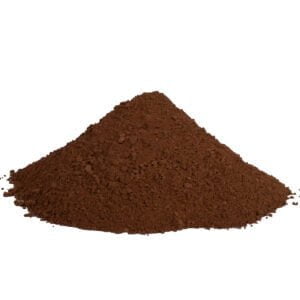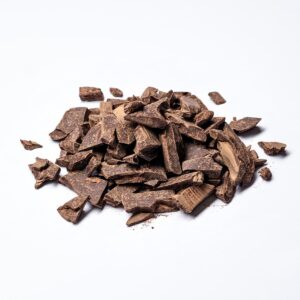Cacao shop
Our cacao shop offers a wide variety of ceremonial cacao (100% cacao paste), delicious chocolates, many types of cocoa powder, as well as beans, nibs, and cacao butter.
The taste of each type of cacao depends on its place of origin of the beans and the species of cacao, which is why we import cacao from many corners of the world – from the Peruvian Amazon to the paradise island of Bali.
3 products
-
Sale!
 This product has multiple variants. The options may be chosen on the product page
This product has multiple variants. The options may be chosen on the product pageAfrica Moner Alkalised
Alkalised Cocoa Powder 10/12% From 19,00 zł / 250 g -
Sale!
 This product has multiple variants. The options may be chosen on the product page
This product has multiple variants. The options may be chosen on the product pageVenezuela Río Caribe
Cacao Ceremonial Original price was: 75,00 zł.69,00 złCurrent price is: 69,00 zł. / 250 gLowest price prior to sale: 75,00 zł -
Sale!
 This product has multiple variants. The options may be chosen on the product page
This product has multiple variants. The options may be chosen on the product pageHojicha
Roasted green tea From 49,00 zł / 30 g
Cacao is a product with many faces: it can be dry, bitter or contain subtle notes of sweetness. It can also be used in areas of life other than cooking, as it is great as a natural cosmetic!
Ceremonial cacao, a 100% paste made from ground cacao beans
It takes the shape of blocks, chunks, or pellets with the consistency of hard chocolate. In fact, ceremonial cacao is just the truest, 100% chocolate with no artificial additives. True cacao is characterised by its natural bitterness, but the different varieties vary in flavour – some even seem sweet! The spectrum of all cacao flavours is a real Amazon jungle of sensations!
Use of full-fat cacao
Ceremonial cacao (full-fat cacao paste, cacao liquor) is suitable for making an aromatic drink and making chocolate, but it can also be used as a natural skin mask and even for massage! Unflavoured cacao usually contains about 50% cacao fat.
Drinking or food-grade chocolates, or simply sweeter cacao
Chocolates usually take the form of pellets to make them easier to dissolve in milk or water. They are differentiated from ceremonial cacao (cacao paste, cacao liquor) by their lower cacao content and additives such as milk powder, cacao butter and sugars and natural flavourings. This product is often referred to as hot chocolate, although it can also be consumed cold.
Uses of drinking or eating chocolate
Dissolve the chocolates in milk or water, in a ratio of 1 to 2 – this produces a thick, essential drink with a high nutritional value. The chocolate can also be used as a confectionery glaze or filling for pralines.
Chocolates in bars
It would seem that this concept needs no explanation, but bar chocolate differs from food-grade chocolate in an important detail: the former is conched for longer (mixed and ground at the same time) and undergoes an additional process of tempering, i.e. alternating heating and cooling. This is what gives the chocolate the right crystalline texture and crunchiness that makes sharing it accompanied by a characteristic ‘click’.
Types of chocolate in bars
Our shop is stocked with many different types of chocolate bars: cacao fans will find milk chocolate, dark chocolate, and cooking chocolate, as well as white and pink! In short: there is plenty to choose from!
Cocoa powder, the brother of cacao butter
As the name suggests, this cacao is in the form of a fine powder, which is produced after grinding what is known as “cacao kejk”. What is this “cacao kejk?”. This polonised term (from “cake”) is used to describe the round cake-shaped moulding that is formed after the original cacao mass has been pressed and skimmed. Because of this latter process, cocoa powder contains less fat than cacao paste (i.e. between 10% and 24%).
Uses of cocoa powder
Cocoa powder has many culinary uses: it can be used to make a drink or cake, and when combined with cacao butter it is also suitable for making homemade chocolates. Contrary to popular belief, it is a 100% natural and refined product.
Alkalized and natural cacao
There are two types of cocoa powder: natural, with a light brown-red colour, and alkalized (also known as Dutch Cacao), which takes on a dark brown or even black colour.
While in the case of natural cacao everything is clear because it is defatted cacao without any additive, alkalised cacao is treated with a strong alkali (potassium hydroxide) during the production process to obtain a darker colour and milder taste.
Cacao butter, the kitchen gamechanger and friend of your skin
The name would indicate that this product has the consistency of a soft spread, but it is worth knowing that at room temperature cacao butter is slightly harder than its regular counterpart – it also has a much more intense yellow colour. A natural white residue sometimes appears on cacao butter, which consists of precipitated fat particles.
There are two types of cacao butter: natural butter and deodorised butter. It is the latter type of butter that is largely odourless. Other than that, the properties of both types are similar, but they have slightly different uses.
Uses of cacao butter
Cacao butter is a true friend to your skin. You can make creams with it or apply it directly. Butter brightens the skin, regenerates it, nourishes it, and removes blemishes. If you like to smell of chocolate – use natural butter; if you prefer a conventional perfume, deodorised butter will be right for you.
Cacao fat is very stable and, of course, is also great for all kitchen applications, especially for making white chocolate and other confectionery products.
Raw cocoa beans
The cacao fruit contains large beans (from 1 to 3 cm long) which, after being removed, undergo a process of fermentation for several days and drying. They are then ground to produce cacao paste, which will one day be used to make aromatic chocolate.
Consumption of cacao beans
Raw Cacao beans are dried but not roasted, and it is therefore advisable to undergo this process before grinding in order to sterilise them and create the right flavour profile. Unroasted beans are not suitable for consumption!
Cacao nibs
Nibs are hulled and crushed cacao beans. They come in two forms: raw and roasted. The latter is suitable for direct consumption, while raw nibs should be roasted in a dry pan beforehand.
For what are cacao nibs used?
Nibs are the starting product of cacao paste production and, of course: chocolate. They can also be used to flavour various drinks such as chocolate beer. There is also nothing stopping you from simply munching nibs as a healthy snack.
Bio/organic products
We also offer organic products made from cacao beans from certified organic plantations. Organic cacao undergoes testing before being loaded into a container and at the port of destination in Europe.
What is bio-certified?
Bio-certification, also known as organic or ecological certification, is an official document confirming that a product has been produced according to certain organic standards. Products bearing this certificate must meet a series of production, processing and distribution criteria that aim to minimise environmental impact and promote a sustainable economy.
Fair Trade certified cacao
Many of our cacao products are Fair Trade certified. Certified plantations are continuously monitored for working conditions and farmer wages.
What is Fair Trade certification?
Fair Trade certification, also known as Fair Trade certification, is official confirmation that a product comes from a production process that adheres to Fair Trade principles. Products bearing this certification come from companies that provide fair working conditions and fair wages for producers, often in developing countries.
Fair Trade certification organisations adhere to certain standards, which include minimum prices provided to producers, ensuring safe working conditions, promoting the sustainability of local communities, and caring for the environment.
Rainforest-certified cacao
Cacao comes from the rainforests of the Amazon, although nowadays it is not only grown in the Amazon jungle, but throughout the subtropical zone. Some of the products we offer certify that the cacao plantations have no negative impact on the environment and that they are grown in an ecologically sustainable way.
What is Rainforest certification?
Rainforest Alliance certification is official confirmation that a product or company meets certain standards for sustainable agriculture, environmental protection, and the wellbeing of local communities.
Products bearing this certification come from farms, plantations or companies that follow guidelines to protect the rainforest, minimise environmental impact, protect biodiversity and improve working and living conditions for local communitie
Wholesale cacao
All the products we offer are also available in wholesale: from the proverbial jute bag of raw beans to containers full of aromatic cacao. This is why our offer is aimed at small shops and cafés as well as large-scale producers of chocolate or other confectionery products.
Wholesale cacao delivery times depend on product availability and order volume. However, we always aim for our goods to reach the customer within a few days or – at the most – a few weeks.
Custom cacao paste production
We have a wide range of high-quality cacao beans from which we produce cacao paste to order for shops, chocolatiers, and chocolate makers. The order volume depends on the customer’s needs – we can supply any quantity of delicious cacao paste!



